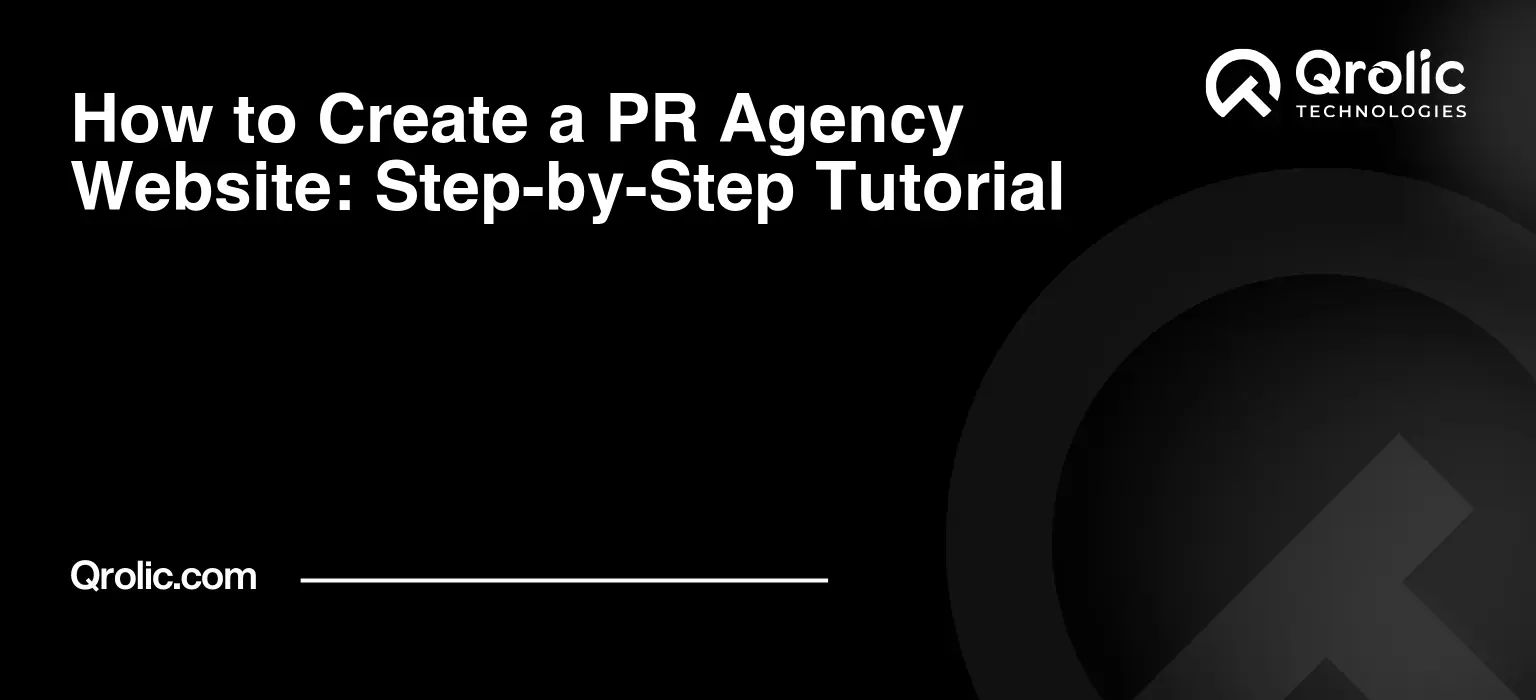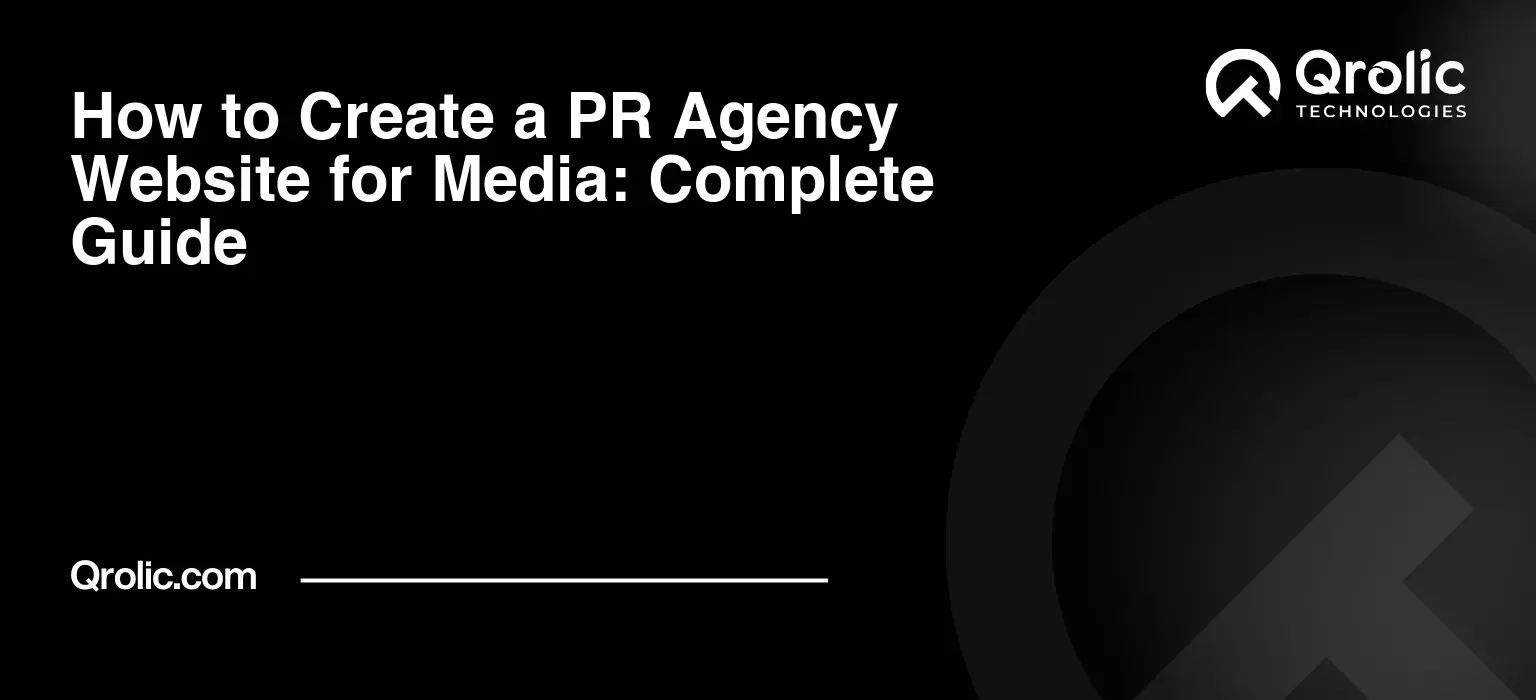Quick Summary:
- Plan your website: define audience and goals.
- Design user-friendly site with clear content.
- Optimize for search engines; integrate vital tools.
- Maintain and update your website regularly.
Table of Contents
- 1. Understanding the Core: Why Your PR Agency Needs a Stellar Website
- 1.1. The Website as Your Digital Business Card
- 1.2. Showcasing Your PR Prowess: Beyond Just Saying It
- 1.3. Lead Generation and Client Acquisition: Turning Browsers into Buyers
- 2. Laying the Foundation: Planning Your PR Agency Website
- 2.1. Defining Your Target Audience: Who Are You Trying to Reach?
- 2.2. Setting Clear Goals: What Do You Want Your Website to Achieve?
- 2.3. Crafting a Site Map: Organizing Your Website’s Structure
- 3. Choosing the Right Platform: WordPress vs. Other Options
- 3.1. The Power of WordPress: Flexibility, Scalability, and SEO Friendliness
- 3.2. Exploring Alternatives: Wix, Squarespace, and Webflow
- 3.3. Making the Right Choice: Factors to Consider
- 4. Design Matters: Creating a Visually Compelling Website
- 4.1. Branding Consistency: Aligning Your Website with Your Agency’s Identity
- 4.2. User-Friendly Navigation: Guiding Visitors to the Information They Need
- 4.3. Mobile Responsiveness: Ensuring Your Website Looks Great on All Devices
- 4.4. High-Quality Visuals: Using Images and Videos to Enhance Your Message
- 5. Content is King: Creating Engaging and Informative Website Copy
- 5.1. Crafting a Compelling Value Proposition: What Makes Your Agency Unique?
- 5.2. Writing Clear and Concise Copy: Communicating Effectively with Your Audience
- 5.3. Showcasing Your Expertise: Sharing Insights and Thought Leadership
- 5.4. Case Studies: Demonstrating Your Success Stories with Data
- 6. SEO Optimization: Ensuring Your Website Ranks High in Search Results
- 6.1. Keyword Research: Identifying the Terms Your Target Audience is Searching For
- 6.2. On-Page Optimization: Optimizing Your Website’s Content and Structure
- 6.3. Off-Page Optimization: Building High-Quality Backlinks
- 6.4. Technical SEO: Ensuring Your Website is Crawlable and Indexable
- 7. Integrating Essential Tools: Enhancing Your Website’s Functionality
- 7.1. Google Analytics: Tracking Your Website’s Performance
- 7.2. Email Marketing: Building Relationships and Generating Leads
- 7.3. Social Media Management: Amplifying Your Content and Engaging with Your Audience
- 7.4. CRM Integration: Managing Your Leads and Clients
- 8. Qrolic Technologies: Your Partner in Digital Success
- 9. Launching Your Website: Ensuring a Smooth Go-Live Process
- 9.1. Thorough Testing: Checking for Errors and Broken Links
- 9.2. Cross-Browser Compatibility: Ensuring Your Website Works on All Browsers
- 9.3. Mobile Responsiveness Verification: Ensuring Optimal Mobile Experience
- 9.4. Setting Up Google Analytics: Tracking Website Performance from Day One
- 9.5. Backup Your Website: Safeguarding Your Data
- 10. Post-Launch Maintenance: Keeping Your Website Fresh and Up-to-Date
- 10.1. Regular Content Updates: Keeping Your Website Engaging and Relevant
- 10.2. Plugin and Theme Updates: Ensuring Security and Functionality
- 10.3. Security Monitoring: Protecting Your Website from Threats
- 10.4. Performance Monitoring: Ensuring Optimal Website Speed
1. Understanding the Core: Why Your PR Agency Needs a Stellar Website
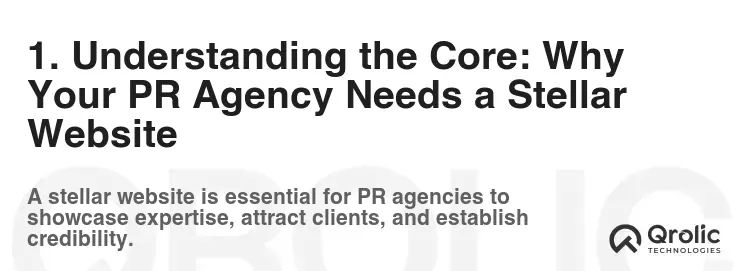
Your website isn’t just a digital brochure; it’s the cornerstone of your agency’s online presence and a powerful lead-generation engine. In the fast-paced world of Public Relations, where reputation is everything, your website is often the first impression you make on potential clients, journalists, and industry influencers. A well-crafted website communicates your expertise, showcases your successful campaigns, and positions you as a leader in the field.
1.1. The Website as Your Digital Business Card
Think of your website as an interactive business card. It’s available 24/7, providing instant access to your agency’s key information, services, and contact details. It’s a dynamic platform where you can constantly update your portfolio, share insightful articles, and demonstrate your industry knowledge.
- Accessibility: Clients worldwide can access your information at any time.
- First Impressions Matter: A visually appealing and user-friendly website immediately establishes credibility.
- Information Hub: Centralizes all your agency’s essential details in one place.
1.2. Showcasing Your PR Prowess: Beyond Just Saying It
Anyone can claim to be a great PR agency. Your website is where you prove it. Detailed case studies, compelling client testimonials, and impactful results are crucial for demonstrating your capabilities and attracting new business.
- Case Studies are Key: Showcase successful campaigns with quantifiable results.
- Client Testimonials Build Trust: Let your clients speak to your expertise and value.
- Data-Driven Results: Quantify your impact with metrics like media mentions, website traffic increases, and brand sentiment improvements.
1.3. Lead Generation and Client Acquisition: Turning Browsers into Buyers
Your website should be designed to attract, engage, and convert visitors into qualified leads. Implement clear calls to action (CTAs), offer valuable resources (e.g., ebooks, webinars), and optimize your website for search engines to drive targeted traffic to your site.
- Strategic CTAs: Guide visitors towards taking the desired action (e.g., “Request a Consultation,” “Download Our Guide”).
- Valuable Content Marketing: Attract potential clients with informative blog posts, articles, and resources.
- SEO Optimization: Ensure your website ranks highly in search results for relevant keywords.
2. Laying the Foundation: Planning Your PR Agency Website

Before you even think about design or code, you need a solid plan. This involves defining your target audience, outlining your website’s goals, and creating a site map that reflects your agency’s structure and services.
2.1. Defining Your Target Audience: Who Are You Trying to Reach?
Understanding your ideal client is paramount. Are you targeting startups, established corporations, or specific industries? Tailor your website’s messaging, design, and content to resonate with their specific needs and pain points.
- Industry Focus: Are you specializing in technology, healthcare, or consumer goods?
- Company Size: Do you work primarily with small businesses or large enterprises?
- Budget Considerations: What is the typical budget range of your target clients?
2.2. Setting Clear Goals: What Do You Want Your Website to Achieve?
What are your primary objectives for your website? Is it to generate leads, build brand awareness, or showcase your portfolio? Define measurable goals to track your website’s performance and make data-driven improvements.
- Lead Generation: Increase the number of qualified leads generated per month.
- Brand Awareness: Improve brand recognition and visibility within your target market.
- Portfolio Showcase: Highlight successful case studies and client testimonials.
- Thought Leadership: Establish your agency as an industry authority through valuable content.
2.3. Crafting a Site Map: Organizing Your Website’s Structure
A well-organized site map ensures a seamless user experience and helps search engines understand your website’s hierarchy. Plan the key pages and sections of your website, including your homepage, services pages, case studies, blog, and contact page.
- Homepage: The first impression of your agency. Should be visually appealing, clearly communicate your value proposition, and guide visitors to key sections.
- About Us: Tell your agency’s story, highlight your team’s expertise, and build trust with potential clients.
- Services: Clearly outline the PR services you offer, such as media relations, crisis communications, social media management, and content marketing.
- Case Studies: Showcase your successful campaigns with detailed descriptions, quantifiable results, and client testimonials.
- Blog: Share insightful articles, industry news, and thought leadership pieces to attract potential clients and improve your website’s SEO.
- Contact Us: Provide clear contact information and a user-friendly contact form to make it easy for potential clients to reach you.
3. Choosing the Right Platform: WordPress vs. Other Options
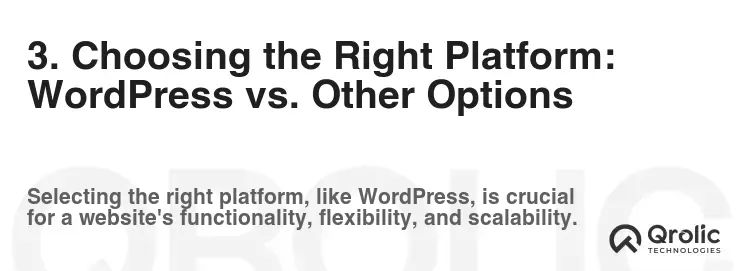
Selecting the right platform for your PR agency website is a crucial decision. WordPress is a popular and versatile option, offering flexibility, customization, and a vast ecosystem of plugins and themes. However, other platforms like Wix, Squarespace, and Webflow may also be suitable depending on your specific needs and technical expertise.
3.1. The Power of WordPress: Flexibility, Scalability, and SEO Friendliness
WordPress is a content management system (CMS) that empowers you to create and manage your website with ease. Its open-source nature, extensive plugin library, and SEO-friendly architecture make it an ideal choice for PR agencies.
- Flexibility: WordPress offers unparalleled flexibility in terms of design, functionality, and customization.
- Scalability: As your agency grows, WordPress can easily scale to accommodate your expanding needs.
- SEO Friendliness: WordPress is inherently SEO-friendly, allowing you to optimize your website for search engines and drive organic traffic.
- Plugin Ecosystem: Access thousands of plugins to extend your website’s functionality, from SEO tools to contact form builders.
3.2. Exploring Alternatives: Wix, Squarespace, and Webflow
While WordPress is a powerful option, other platforms may be suitable for agencies with specific needs or limited technical expertise.
- Wix: A drag-and-drop website builder that is easy to use, but offers less flexibility and customization compared to WordPress.
- Squarespace: Another user-friendly website builder with a focus on design, but can be more expensive than WordPress in the long run.
- Webflow: A more advanced website builder that offers greater design control, but requires a steeper learning curve.
3.3. Making the Right Choice: Factors to Consider
When choosing a platform, consider factors such as your budget, technical expertise, desired level of customization, and long-term scalability needs.
- Budget: WordPress is generally more cost-effective in the long run, especially with self-hosting options.
- Technical Expertise: If you have limited technical skills, a user-friendly website builder like Wix or Squarespace might be a better option.
- Customization Needs: If you require a highly customized website, WordPress is the most flexible platform.
- Scalability: Consider how your website will need to scale as your agency grows in the future.
4. Design Matters: Creating a Visually Compelling Website
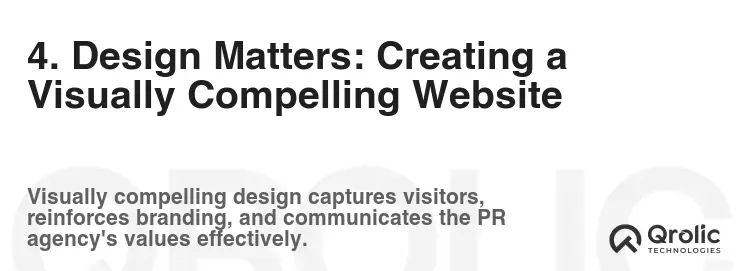
Your website’s design is crucial for attracting and engaging visitors. It should be visually appealing, user-friendly, and reflect your agency’s brand identity.
4.1. Branding Consistency: Aligning Your Website with Your Agency’s Identity
Ensure your website’s design aligns with your agency’s brand guidelines, including your logo, color palette, typography, and overall aesthetic. This consistency reinforces your brand identity and creates a cohesive experience for visitors.
- Logo Integration: Prominently display your agency’s logo on your website.
- Color Palette: Use your brand colors consistently throughout your website’s design.
- Typography: Choose fonts that are legible, visually appealing, and consistent with your brand identity.
4.2. User-Friendly Navigation: Guiding Visitors to the Information They Need
A clear and intuitive navigation structure is essential for a positive user experience. Make it easy for visitors to find the information they need by organizing your website’s content logically and using clear and concise menu labels.
- Simple Menu Structure: Keep your main navigation menu simple and easy to understand.
- Clear Labels: Use clear and concise labels for your menu items.
- Search Functionality: Implement a search function to allow visitors to quickly find specific information.
4.3. Mobile Responsiveness: Ensuring Your Website Looks Great on All Devices
In today’s mobile-first world, it’s crucial that your website is responsive and looks great on all devices, including smartphones, tablets, and desktops. A responsive design ensures a consistent user experience regardless of the device being used.
- Mobile-Friendly Testing: Regularly test your website on different devices to ensure it is fully responsive.
- Optimized Images: Optimize images for mobile devices to reduce loading times.
- Touch-Friendly Navigation: Ensure your website’s navigation is easy to use on touch screen devices.
4.4. High-Quality Visuals: Using Images and Videos to Enhance Your Message
High-quality images and videos can significantly enhance your website’s visual appeal and help you communicate your agency’s message more effectively. Use professional-quality photos of your team, your office, and your successful campaigns.
- Professional Photography: Invest in professional photography to showcase your team and your office.
- Video Testimonials: Use video testimonials from satisfied clients to build trust and credibility.
- Compelling Visuals: Choose images and videos that are visually appealing and relevant to your content.
5. Content is King: Creating Engaging and Informative Website Copy

Your website’s content is just as important as its design. It should be engaging, informative, and optimized for search engines.
5.1. Crafting a Compelling Value Proposition: What Makes Your Agency Unique?
Your value proposition is a clear and concise statement that communicates what makes your agency unique and why potential clients should choose you over the competition. It should be prominently displayed on your homepage and throughout your website.
- Focus on Benefits, Not Features: Highlight the benefits that clients will receive by working with your agency.
- Quantify Your Results: Use data and metrics to demonstrate the impact of your services.
- Differentiate Yourself: Emphasize what sets your agency apart from the competition.
5.2. Writing Clear and Concise Copy: Communicating Effectively with Your Audience
Use clear and concise language that is easy for your target audience to understand. Avoid jargon and technical terms, and focus on communicating your message in a straightforward and engaging manner.
- Use Short Sentences and Paragraphs: Make your content easy to read and digest.
- Use Bullet Points and Lists: Break up large blocks of text and make information more accessible.
- Write in an Active Voice: Use an active voice to make your writing more engaging and direct.
5.3. Showcasing Your Expertise: Sharing Insights and Thought Leadership
Establish your agency as an industry authority by sharing insightful articles, blog posts, and thought leadership pieces on your website. This will attract potential clients, improve your website’s SEO, and build trust with your audience.
- Regular Blog Posts: Publish new blog posts regularly to keep your website fresh and engaging.
- Industry News and Trends: Share your insights on the latest industry news and trends.
- Thought Leadership Articles: Position your agency as a thought leader by sharing original research and perspectives.
5.4. Case Studies: Demonstrating Your Success Stories with Data
Detailed case studies are essential for demonstrating your agency’s capabilities and attracting new business. Each case study should include a clear description of the client’s challenges, the strategies you implemented, and the quantifiable results you achieved.
- Client Challenges: Clearly outline the challenges that the client was facing.
- Strategies Implemented: Describe the strategies you used to address the client’s challenges.
- Quantifiable Results: Quantify the results you achieved with metrics like media mentions, website traffic increases, and brand sentiment improvements.
6. SEO Optimization: Ensuring Your Website Ranks High in Search Results

Search engine optimization (SEO) is crucial for driving organic traffic to your website and attracting potential clients. Optimize your website for relevant keywords, build high-quality backlinks, and ensure your website is mobile-friendly and loads quickly.
6.1. Keyword Research: Identifying the Terms Your Target Audience is Searching For
Keyword research is the foundation of any successful SEO strategy. Identify the keywords that your target audience is searching for and incorporate them strategically into your website’s content, titles, and meta descriptions.
- Use Keyword Research Tools: Use tools like Google Keyword Planner, Ahrefs, and SEMrush to identify relevant keywords.
- Focus on Long-Tail Keywords: Target long-tail keywords (longer, more specific phrases) to attract highly qualified traffic.
- Analyze Competitor Keywords: Analyze the keywords that your competitors are ranking for.
6.2. On-Page Optimization: Optimizing Your Website’s Content and Structure
On-page optimization involves optimizing your website’s content and structure to improve its ranking in search results. This includes optimizing your titles, meta descriptions, headings, and image alt tags.
- Title Tags: Use relevant keywords in your title tags to improve your website’s visibility in search results.
- Meta Descriptions: Write compelling meta descriptions that entice users to click on your website in search results.
- Heading Tags: Use heading tags (H1, H2, H3) to structure your content and make it easier to read.
- Image Alt Tags: Use descriptive alt tags for your images to improve your website’s accessibility and SEO.
6.3. Off-Page Optimization: Building High-Quality Backlinks
Off-page optimization involves building high-quality backlinks from other websites to your website. Backlinks are a signal to search engines that your website is authoritative and trustworthy.
- Guest Blogging: Write guest posts for other websites in your industry and include a link back to your website.
- Link Building: Participate in link building activities like broken link building and resource link building.
- Social Media Promotion: Promote your website’s content on social media to increase its visibility and attract backlinks.
6.4. Technical SEO: Ensuring Your Website is Crawlable and Indexable
Technical SEO involves ensuring that your website is crawlable and indexable by search engines. This includes optimizing your website’s speed, mobile-friendliness, and site architecture.
- Website Speed: Optimize your website’s speed by compressing images, using a caching plugin, and choosing a fast hosting provider.
- Mobile-Friendliness: Ensure your website is mobile-friendly by using a responsive design.
- Site Architecture: Create a clear and logical site architecture to make it easy for search engines to crawl and index your website.
- XML Sitemap: Submit an XML sitemap to search engines to help them crawl and index your website more efficiently.
7. Integrating Essential Tools: Enhancing Your Website’s Functionality
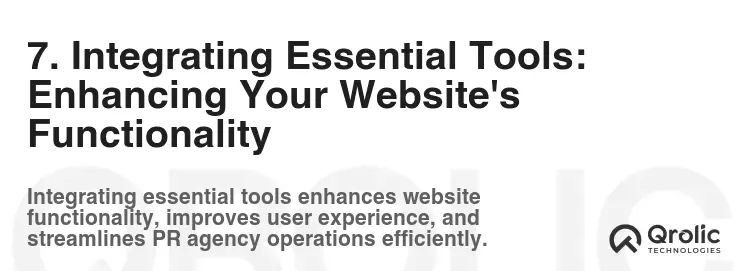
Integrating essential tools can significantly enhance your website’s functionality and help you achieve your business goals. This includes tools for analytics, email marketing, social media management, and customer relationship management (CRM).
7.1. Google Analytics: Tracking Your Website’s Performance
Google Analytics is a free web analytics tool that allows you to track your website’s traffic, user behavior, and conversion rates. Use Google Analytics to monitor your website’s performance, identify areas for improvement, and measure the success of your marketing campaigns.
- Track Key Metrics: Track metrics like website traffic, bounce rate, time on page, and conversion rates.
- Analyze User Behavior: Analyze how users are interacting with your website to identify areas for improvement.
- Measure Campaign Performance: Track the performance of your marketing campaigns to see which ones are most effective.
7.2. Email Marketing: Building Relationships and Generating Leads
Email marketing is a powerful tool for building relationships with potential clients, nurturing leads, and promoting your agency’s services. Integrate an email marketing platform like Mailchimp, Constant Contact, or ConvertKit with your website to capture leads, send newsletters, and automate email campaigns.
- Capture Leads: Use opt-in forms to capture leads on your website.
- Send Newsletters: Send regular newsletters to keep your audience informed about your agency’s latest news and insights.
- Automate Email Campaigns: Automate email campaigns to nurture leads and guide them through the sales process.
7.3. Social Media Management: Amplifying Your Content and Engaging with Your Audience
Social media is an essential tool for promoting your agency’s content, engaging with your audience, and building brand awareness. Integrate a social media management tool like Hootsuite, Buffer, or Sprout Social with your website to schedule posts, track engagement, and monitor your social media presence.
- Schedule Posts: Schedule social media posts in advance to save time and ensure consistent posting.
- Track Engagement: Track engagement metrics like likes, shares, and comments to measure the success of your social media campaigns.
- Monitor Your Social Media Presence: Monitor your social media mentions to identify opportunities to engage with your audience and address any concerns.
7.4. CRM Integration: Managing Your Leads and Clients
A customer relationship management (CRM) system can help you manage your leads, track client interactions, and streamline your sales process. Integrate a CRM system like Salesforce, HubSpot CRM, or Zoho CRM with your website to automatically capture leads from your contact forms and manage your client relationships more effectively.
- Lead Capture: Automatically capture leads from your website’s contact forms.
- Lead Management: Track the progress of your leads through the sales process.
- Client Management: Manage your client interactions and track client satisfaction.
8. Qrolic Technologies: Your Partner in Digital Success
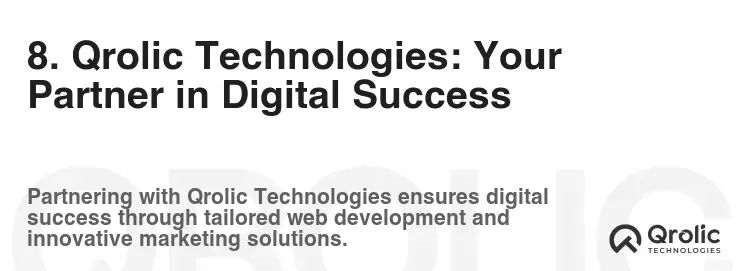
Qrolic Technologies (https://qrolic.com/) understands the unique challenges faced by PR agencies in today’s digital landscape. We offer a range of web development and digital marketing services tailored to help PR agencies build a strong online presence, attract new clients, and achieve their business goals.
- Custom Website Development: We design and develop custom websites that are visually appealing, user-friendly, and optimized for search engines.
- SEO Optimization: We help PR agencies improve their website’s ranking in search results and drive organic traffic to their site.
- Content Marketing: We create engaging and informative content that attracts potential clients and establishes your agency as a thought leader.
- Social Media Marketing: We help PR agencies build a strong social media presence, engage with their audience, and drive leads.
Partner with Qrolic Technologies to create a website that not only showcases your agency’s expertise but also drives measurable results.
9. Launching Your Website: Ensuring a Smooth Go-Live Process
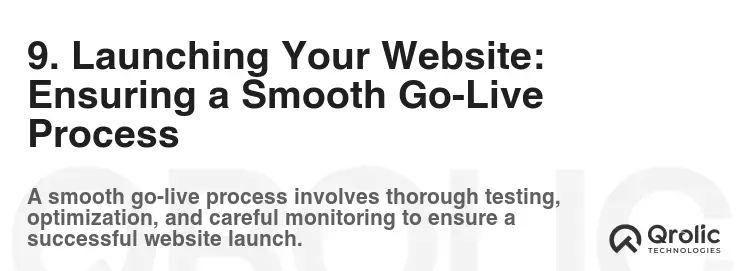
Launching your website is a critical step. Before you go live, carefully review everything to ensure a smooth and successful launch.
9.1. Thorough Testing: Checking for Errors and Broken Links
Before launching your website, thoroughly test all pages, links, and forms to ensure everything is working correctly. Check for broken links, spelling errors, and any other issues that could negatively impact the user experience.
- Test All Pages: Visit every page on your website to ensure it is displaying correctly.
- Check All Links: Click on all links to ensure they are working and directing users to the correct pages.
- Test All Forms: Submit test submissions to all forms to ensure they are functioning properly and that you are receiving the data.
9.2. Cross-Browser Compatibility: Ensuring Your Website Works on All Browsers
Test your website on different web browsers (e.g., Chrome, Firefox, Safari, Edge) to ensure it is displaying correctly and functioning properly on all of them.
- BrowserStack: Use a tool like BrowserStack to test your website on a variety of browsers and operating systems.
- Mobile Testing: Ensure your website is displaying correctly on mobile devices as well.
9.3. Mobile Responsiveness Verification: Ensuring Optimal Mobile Experience
Verify that your website is fully responsive and looks great on all mobile devices. Use a mobile testing tool or simply browse your website on your smartphone and tablet to ensure it is providing an optimal user experience.
- Google Mobile-Friendly Test: Use Google’s Mobile-Friendly Test tool to check if your website is mobile-friendly.
- Responsive Design: Ensure your website is using a responsive design that adapts to different screen sizes.
9.4. Setting Up Google Analytics: Tracking Website Performance from Day One
Before you launch your website, set up Google Analytics to track your website’s traffic and user behavior from day one. This will allow you to monitor your website’s performance, identify areas for improvement, and measure the success of your marketing campaigns.
- Google Analytics Account: Create a Google Analytics account and add your website to the account.
- Tracking Code: Install the Google Analytics tracking code on all pages of your website.
- Goal Setting: Set up goals in Google Analytics to track key conversions, such as form submissions and email sign-ups.
9.5. Backup Your Website: Safeguarding Your Data
Before launching your website, create a complete backup of your website files and database. This will allow you to restore your website quickly and easily in case of any unforeseen issues.
- Backup Plugin: Use a backup plugin like UpdraftPlus or BackupBuddy to automate the backup process.
- Offsite Storage: Store your backups in a secure offsite location, such as cloud storage or an external hard drive.
10. Post-Launch Maintenance: Keeping Your Website Fresh and Up-to-Date
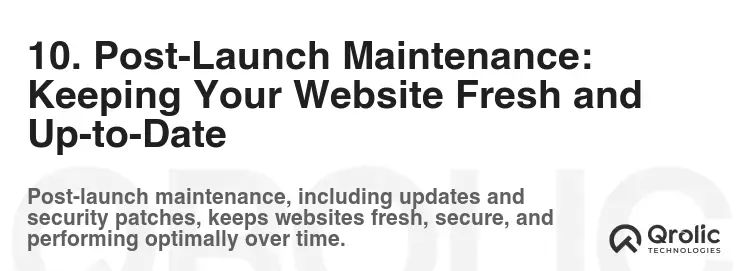
Launching your website is just the beginning. Ongoing maintenance is essential for keeping your website fresh, secure, and up-to-date.
10.1. Regular Content Updates: Keeping Your Website Engaging and Relevant
Regularly update your website’s content with fresh articles, blog posts, case studies, and news to keep your website engaging, relevant, and attractive to potential clients.
- Content Calendar: Create a content calendar to plan and schedule your content updates.
- Fresh Content: Regularly publish new content to keep your website fresh and engaging.
- Relevant Information: Ensure your content is relevant to your target audience and provides valuable information.
10.2. Plugin and Theme Updates: Ensuring Security and Functionality
Regularly update your website’s plugins and themes to ensure security and functionality. Outdated plugins and themes can be vulnerable to security threats and may not be compatible with the latest version of your CMS.
- Automatic Updates: Enable automatic updates for your plugins and themes to ensure they are always up-to-date.
- Compatibility Testing: Before updating plugins or themes, test them on a staging environment to ensure they are compatible with your website.
10.3. Security Monitoring: Protecting Your Website from Threats
Implement security measures to protect your website from threats, such as malware, hacking attempts, and data breaches. This includes installing a security plugin, using strong passwords, and regularly backing up your website.
- Security Plugin: Install a security plugin like Wordfence or Sucuri Security to protect your website from threats.
- Strong Passwords: Use strong, unique passwords for all your website accounts.
- Regular Backups: Regularly back up your website to ensure you can restore it quickly in case of a security breach.
10.4. Performance Monitoring: Ensuring Optimal Website Speed
Monitor your website’s performance to ensure it is loading quickly and providing a positive user experience. slow loading times can negatively impact your website’s SEO and user engagement.
- Website Speed Test: Use a website speed test tool like Google PageSpeed Insights or GTmetrix to measure your website’s loading time.
- Performance Optimization: Optimize your website’s performance by compressing images, using a caching plugin, and choosing a fast hosting provider.
By following these steps, you can create a professional and effective website for your PR agency that attracts new clients, showcases your expertise, and helps you achieve your business goals. Remember, your website is a living, breathing entity that requires constant attention and care. Embrace the process of continuous improvement and watch your online presence flourish.
